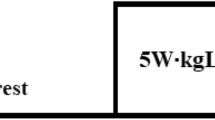Summary
Seven male skiers exercised for 30 min on a cycle ergometer at 50% of maximal oxygen uptake and an ambient temperature of 5° C. The exercise was preceded either by cold exposure (PREC) or active warming-up (PREH). The data were compared with control exercise (CONT) performed immediately after entering the thermal chamber from a thermoneutral environment. Cold exposure resulted in negative heat storage (96.1 kJ·m−2, SE 5.9) leading to significantly lower rectal, mean body and mean skin temperatures at the onset of exercise in PREC, as compared to PREH and CONT. The PREC-PREH temperature differences were still significant at the end of the exercise period. During exercise in the PREC test, oxygen uptake was higher than in PREH test (32.8 ml·kg−1·min−1, SE 1.5 vs 30.5 ml·kg−1·min−1, SE 1.3, respectively). Heart rate showed only a tendency to be higher in PREC than in PREH and CONT tests. In the PREH test skin and body temperatures as well as sweat rate were already elevated at the beginning of exercise. Exercise-induced changes in these variables were minimal. Heat storage decreased with the duration of the exercise. Exercise at low ambient temperature preceded by a 30-min rest in a cold environment requires more energy than the same exercise performed after PREH.
Similar content being viewed by others
References
Beaumont W van, Bullard RW (1963) Sweating: the rapid response to muscular work. Science 141:643–646
Bergh U, Ekblom B (1979a) Physical performance and peak aerobic power at different body temperatures. J Appl Physiol 46:885–889
Bergh U, Ekblom B (1979b) Influence of muscle temperature on muscle strength and power output in human skeletal muscles. Acta Physiol Scand 107:33–37
Blomstrand E, Essén-Gustavsson B (1987) Influence of reduced muscle temperature on metabolism in type I and type II human muscle fibres during intensive exercise. Acta Physiol Scand 131:569–574
Blomstrand E, Bergh U, Essén-Gustavsson B, Ekblom B (1984) Influence of low muscle temperature on muscle metabolism during intense dynamic exercise. Acta Physiol Scand 120:229–236
Brück K, Olschewski H (1987) Body temperature related factors diminishing the drive to exercise. Can J Physiol Pharmacol 65:1274–1280
Brück K, Baum E, Schwennicke HP (1976) Cold-adaptive modifications in man induced by repeated short-term cold-exposures and during 10-day and night cold-exposure. Pflügers Arch 363:125–133
Brück K, Bahner E, Kranning B, Neuman G (1980) Exercise performance and adaptive modifications in the thermoregulatory system. Int J Biometeorol 7:42–53
Chwalbińska-Moneta J, Hänninen O (1989) Effect of active warming up on thermoregulatory, circulatory and metabolic responses to incremental exercise in endurance-trained athletes. Int J Sports Med 10:25–29
Davies M, Ekblom B, Bergh U, Kanstrup IL (1975) The effect of hypothermia on submaximal and maximal work performance. Acta Physiol Scand 95:201–202
Gagge AP, Nishi Y (1977) Heat exchange between human skin surface and thermal environment. In: Lee DHK (ed) Handbook of physiology, section 9. Reactions to environmental agents. American Physiological Society, Bethesda, pp 69–92
Hardy JD, Stolwijk JAJ (1966) Partional calorimetric studies of man during exposures to thermal transients. J Appl Physiol 21:1799–1806
Hessemer V, Langusch D, Brück K, Bödeker RH, Breidenbach T (1984) Effect of slightly lowered body temperatures on endurance performance in humans. J Appl Physiol 57:1731–1737
Hong SK, Nadel ER (1979) Thermogenic control during exercise in a cold environment. J Appl Physiol Respir Environ Exerc Physiol 47:1084–1089
Kaciuba-Uściłko H, Kozłowski S, Brzezińska Z, Nazar K, Turski B, Boruta A (1975) Blood catecholamines and thyroxine at rest and during exercise in men exposed to cold. In: Jansky L (ed) Depressed metabolism and cold thermogenesis. Charles University, Prague, pp 68–72
Olschewski H, Brück K (1988) Thermoregulatory, cardiovascular, and muscular factors related to exercise after precooling. J Appl Physiol 64:803–811
Pugh LGC (1967) Cold stress and muscular exercise with special reference to accidental hypothermia. Br Med J 6:333–337
Schmidt V, Brück K (1981) Effect of precooling maneuver on body temperature and exercise performance. J Appl Physiol 50:772–778
Tiihonen P, Manninen KJ, Hänninen O (1986) Humidity measurement from microenvironmental underneath clothing. Acta Univ Oul A 179:187–190
Author information
Authors and Affiliations
Additional information
This work was partly supported by the Polish Central Programme of Basic Research 06-02.III.2.1.
Rights and permissions
About this article
Cite this article
Kruk, B., Pekkarinen, H., Harri, M. et al. Thermoregulatory responses to exercise at low ambient temperature performed after precooling or preheating procedures. Europ. J. Appl. Physiol. 59, 416–420 (1990). https://doi.org/10.1007/BF02388622
Accepted:
Issue Date:
DOI: https://doi.org/10.1007/BF02388622




